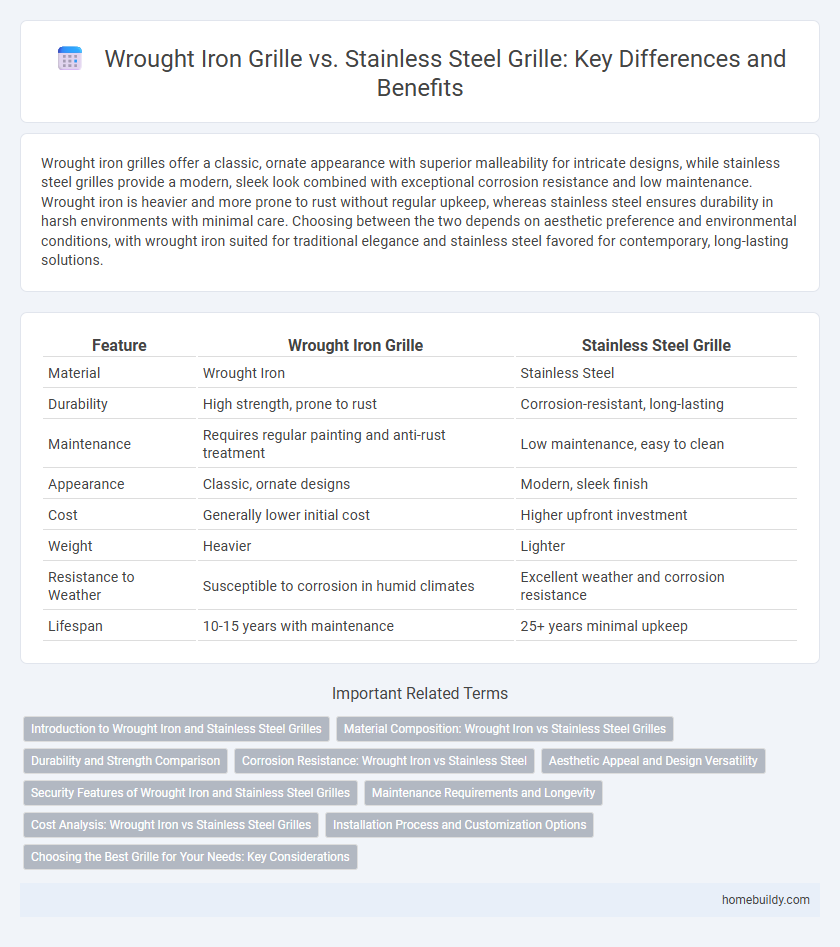Wrought iron grilles offer a classic, ornate appearance with superior malleability for intricate designs, while stainless steel grilles provide a modern, sleek look combined with exceptional corrosion resistance and low maintenance. Wrought iron is heavier and more prone to rust without regular upkeep, whereas stainless steel ensures durability in harsh environments with minimal care. Choosing between the two depends on aesthetic preference and environmental conditions, with wrought iron suited for traditional elegance and stainless steel favored for contemporary, long-lasting solutions.
Table of Comparison
| Feature | Wrought Iron Grille | Stainless Steel Grille |
|---|---|---|
| Material | Wrought Iron | Stainless Steel |
| Durability | High strength, prone to rust | Corrosion-resistant, long-lasting |
| Maintenance | Requires regular painting and anti-rust treatment | Low maintenance, easy to clean |
| Appearance | Classic, ornate designs | Modern, sleek finish |
| Cost | Generally lower initial cost | Higher upfront investment |
| Weight | Heavier | Lighter |
| Resistance to Weather | Susceptible to corrosion in humid climates | Excellent weather and corrosion resistance |
| Lifespan | 10-15 years with maintenance | 25+ years minimal upkeep |
Introduction to Wrought Iron and Stainless Steel Grilles
Wrought iron grilles are renowned for their classic ornamental designs and exceptional durability, often featuring intricate patterns that enhance architectural aesthetics. Stainless steel grilles offer a modern alternative with high resistance to corrosion, low maintenance, and a sleek, polished finish ideal for contemporary settings. Both materials provide robust security solutions, but wrought iron emphasizes traditional elegance while stainless steel prioritizes longevity and minimal upkeep.
Material Composition: Wrought Iron vs Stainless Steel Grilles
Wrought iron grilles are composed primarily of iron with low carbon content, offering high malleability and a classic, ornamental appearance, while stainless steel grilles consist of an alloy containing chromium, nickel, and molybdenum, providing superior corrosion resistance and strength. The carbon content in wrought iron allows for detailed, handcrafted designs but requires regular maintenance to prevent rust and deterioration. Stainless steel's inherent chromium oxide layer creates a durable, low-maintenance surface ideal for modern architectural applications exposed to harsh environmental conditions.
Durability and Strength Comparison
Wrought iron grilles offer exceptional durability due to their heavy-duty composition and resistance to wear, making them ideal for long-lasting security installations. Stainless steel grilles provide superior strength with corrosion resistance, maintaining structural integrity even in harsh weather conditions or high-moisture environments. When comparing durability and strength, wrought iron excels in rigidity and classic aesthetic appeal, while stainless steel outperforms in low maintenance and resilience against rust.
Corrosion Resistance: Wrought Iron vs Stainless Steel
Wrought iron grilles offer classic aesthetics but are prone to rust and corrosion over time without proper maintenance or protective coatings. Stainless steel grilles provide superior corrosion resistance due to their chromium content, making them ideal for outdoor and coastal environments. Choosing stainless steel ensures long-lasting durability and minimal upkeep compared to wrought iron in humid or corrosive conditions.
Aesthetic Appeal and Design Versatility
Wrought iron grilles offer a timeless, classic aesthetic with intricate, handcrafted patterns that enhance architectural elegance. Stainless steel grilles provide a sleek, modern look with high design versatility, resistant to corrosion and suitable for contemporary spaces. Both materials allow customization, but wrought iron excels in ornate detailing while stainless steel supports minimalist and industrial designs.
Security Features of Wrought Iron and Stainless Steel Grilles
Wrought iron grilles offer robust security due to their high tensile strength and resistance to bending, making forced entry extremely difficult. Stainless steel grilles combine strength with corrosion resistance, ensuring long-lasting protection even in harsh weather conditions. Both materials provide secure barriers, but stainless steel grilles are often preferred for environments requiring enhanced durability and minimal maintenance.
Maintenance Requirements and Longevity
Wrought iron grilles require regular maintenance including rust prevention treatments and repainting to preserve their aesthetic appeal and structural integrity, especially in humid or coastal environments. Stainless steel grilles offer superior longevity with minimal maintenance, as their corrosion-resistant properties eliminate the need for frequent upkeep while maintaining strength and durability. Choosing stainless steel significantly reduces long-term maintenance costs and ensures enduring performance in various weather conditions.
Cost Analysis: Wrought Iron vs Stainless Steel Grilles
Wrought iron grilles generally have a lower upfront cost compared to stainless steel grilles but require more frequent maintenance due to susceptibility to rust and corrosion. Stainless steel grilles, while initially more expensive, offer superior durability and lower long-term maintenance expenses, making them a cost-effective option over time. Factoring in lifespan and upkeep, stainless steel provides better value for applications demanding longevity and minimal maintenance.
Installation Process and Customization Options
Wrought iron grilles typically require specialized welding tools and skilled labor for installation due to their heavier weight and intricate designs, offering extensive customization options such as detailed scrollwork and ornamental patterns. Stainless steel grilles feature easier installation with standard hardware and modular components, providing modern customization through sleek finishes and customizable sizes but fewer intricate design possibilities. Both materials demand precise measurements, yet wrought iron allows for more artistic freedom while stainless steel prioritizes durability and low maintenance.
Choosing the Best Grille for Your Needs: Key Considerations
Wrought iron grilles offer a classic, decorative appeal with high durability and good resistance to dents, ideal for traditional or ornate designs. Stainless steel grilles provide superior corrosion resistance, low maintenance, and modern aesthetics, making them suitable for coastal or industrial environments. When choosing, consider factors like environmental exposure, design preferences, budget, and maintenance requirements to select the best grille material for long-term performance.
wrought iron grille vs stainless steel grille Infographic

 homebuildy.com
homebuildy.com